1993 CHEVROLET LUMINA steering wheel
[x] Cancel search: steering wheelPage 135 of 324
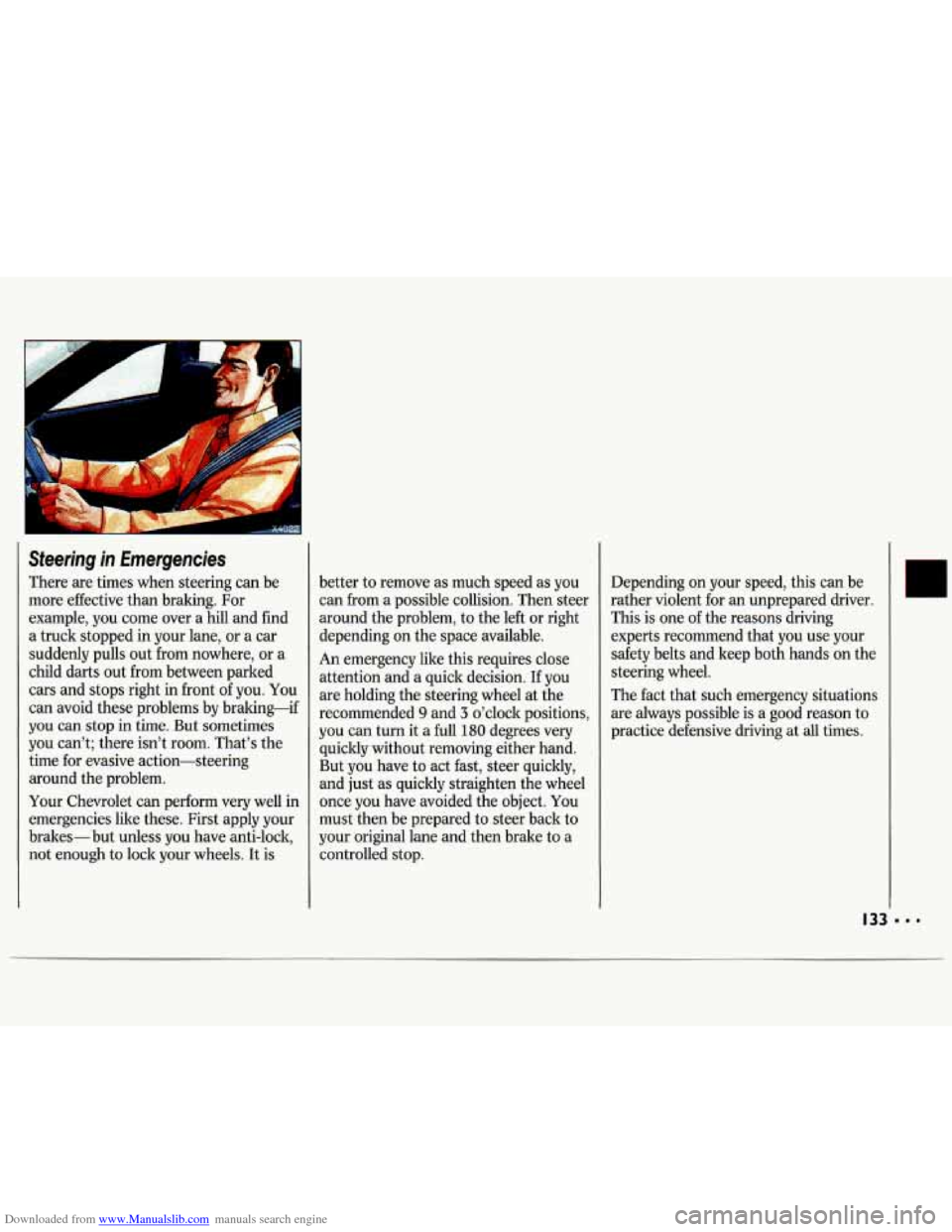
Downloaded from www.Manualslib.com manuals search engine Steering in Emergencies
There are times when steering can be
more effective than braking. For
example, you come over a hill and find
a truck stopped in your lane, or
a car
suddenly pulls out from nowhere, or a
child darts out from between parked
cars and stops right in front
of you. You
can avoid these problems by braking-if
you can stop in time. But sometimes
you can’t; there isn’t room. That’s the
time for evasive action-steering around the problem.
Your Chevrolet can perform very well in
emergencies like these. First apply your
brakes- but unless you have anti-lock,
not enough to lock your wheels. It is better
to remove as much speed as you
can from a possible collision. Then steer
around the problem, to the left or right
depending
on the space available.
An emergency like this requires close
attention and a quick decision. If you
are holding the steering wheel at the
recommended
9 and 3 o’clock positions,
you can turn it a full 180 degrees very
quickly without removing either hand.
But you have to act fast, steer quickly,
and just as quickly straighten the wheel
once you have avoided the object. You
must then be prepared to steer back
to
your original lane and then brake to a
controlled stop. Depending
on your speed, this can be
rather violent for an unprepared driver.
This is one of the reasons driving
experts recommend that you use your
safety belts and keep both hands on the
steering wheel.
The fact that such emergency situations
are always possible is a good reason to
practice defensive driving at
all times.
Page 136 of 324
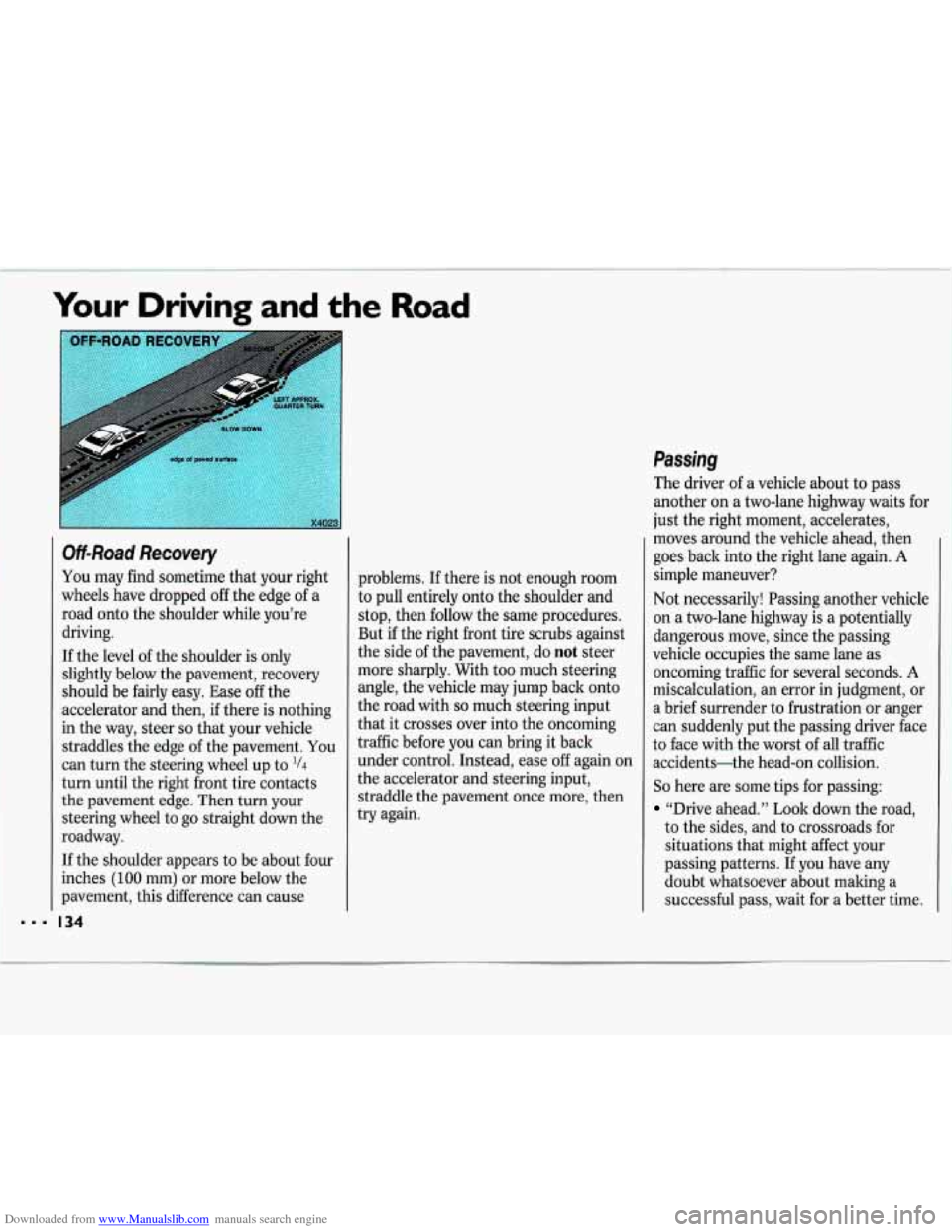
Downloaded from www.Manualslib.com manuals search engine 8.1
Your Driving and the Road
I
OH-Road Recovery
You may find sometime that your right
wheels have dropped off the edge of a
road onto the shoulder while you’re
driving.
If the level of the shoulder is only
slightly below the pavement, recovery
should be fairly easy. Ease
off the
accelerator and then, if there is nothing
in the way, steer
so that your vehicle
straddles the edge of the pavement.
You
can turn the steering wheel up to ‘/4
turn until the right front tire contacts
the pavement edge. Then turn your
steering wheel to go straight down the
roadway.
If the shoulder appears to be about four
inches
(100 mm) or more below the
pavement, this difference can cause
I34
problems. If there is not enough room
to pull entirely onto the shoulder and
stop, then follow the same procedures.
But if the right front tire scrubs against
the side of the pavement, do
not steer
more sharply. With too much steering
angle, the vehicle may jump back onto
the road with
so much steering input
that it crosses over into the oncoming
traffic before you can bring it back
under control. Instead, ease
off again on
the accelerator and steering input,
straddle the pavement once more, then
try again.
Passing
The driver of a vehicle about to pass
another on a two-lane highway waits
for
just the right moment, accelerates,
moves around the vehicle ahead, then
I
goes back into the right lane again. A
simple maneuver?
Not necessarily! Passing another vehicle
on a two-lane highway is a potentially
dangerous move, since the passing
vehicle occupies the same lane as
oncoming traffic for several seconds.
A
miscalculation, an error in judgment, or
a brief surrender to frustration or anger
can suddenly put the passing driver
face
to face with the worst of all traffic
accidents-the head-on collision.
So here are some tips for passing:
“Drive ahead.’’ Look down the road,
to the sides, and to crossroads for
situations that might affect your
passing patterns.
If you have any
doubt whatsoever about malting
a
successful pass, wait for a better time. I
Page 138 of 324
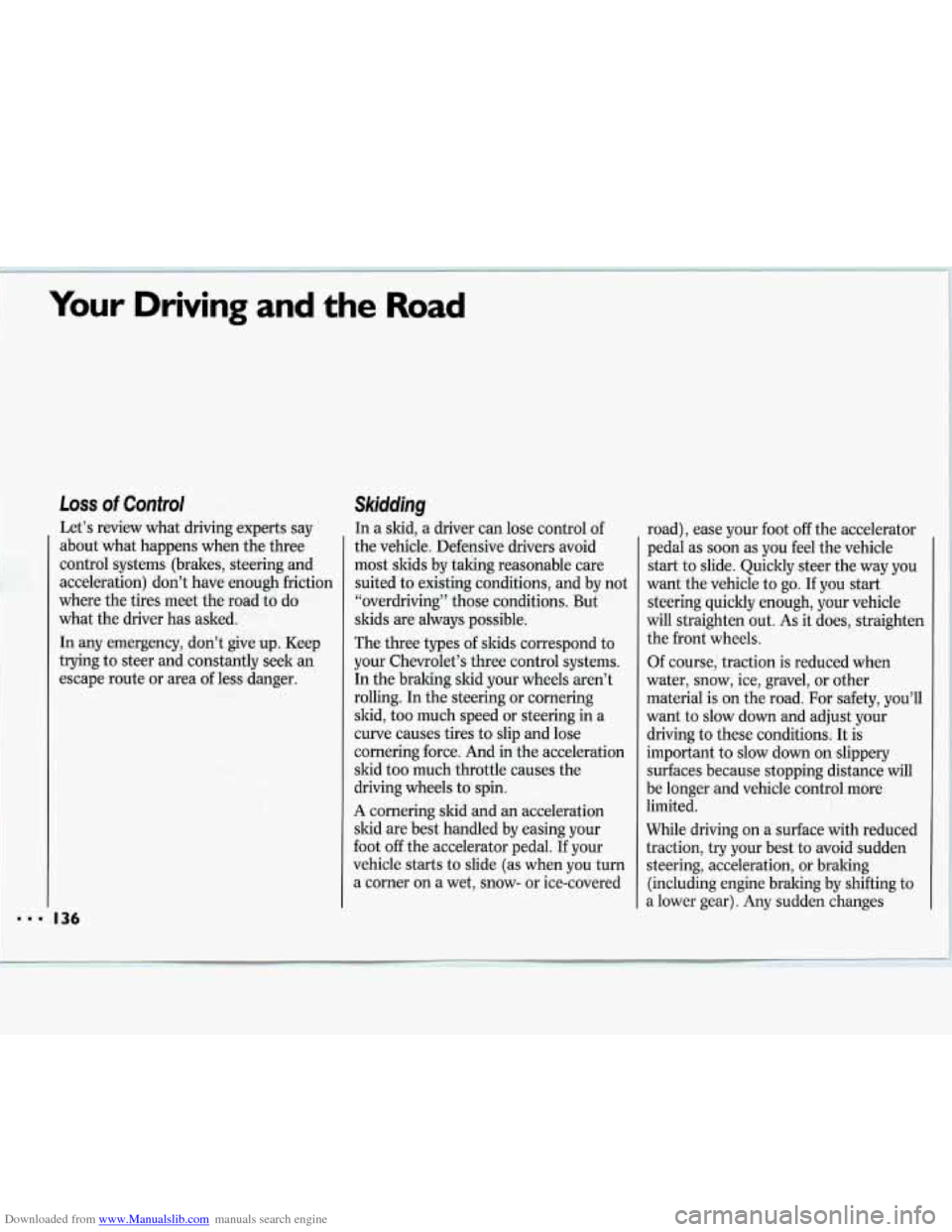
Downloaded from www.Manualslib.com manuals search engine Your Driving and the Road
Loss of Control
Let’s review what driving experts say
about what happens when the three
control systems (brakes, steering and
acceleration) don’t have enough friction
where the tires meet the road to do
what the driver has asked.
In any emergency, don’t give up. Keep
trying to steer and constantly seek an
escape route or area of less danger.
136
Skidding
In a skid, a driver can lose control of
the vehicle. Defensive drivers avoid
most skids by taking reasonable care
suited to existing conditions, and by not
“overdriving” those conditions. But
skids are always possible.
The three types
of skids correspond to
your Chevrolet’s three control systems. In the braking skid your wheels aren’t
rolling. In the steering or cornering
skid, too much speed or steering in a
curve causes tires to slip and lose
cornering force. And in the acceleration
skid too much throttle causes the
driving wheels to spin.
A cornering skid and an acceleration
skid are best handled by easing your
foot
off the accelerator pedal. If your
vehicle starts to slide (as when you turn
a corner on a wet, snow- or ice-covered road),
ease your foot
off the accelerator
pedal as soon as you feel the vehicle
start to slide. Quickly steer the way you
want the vehicle to go. If you start
steering quickly enough, your vehicle
will straighten out.
As it does, straighten
the front wheels.
Of course, traction is reduced when
I 1
water, snow, ice, gravel, or other
material is on the road. For safety, you’ll
I I
want to slow down and adjust your
driving to these conditions. It is
important to slow down
on slippery
surfaces because stopping distance will
be longer and vehicle control more
limited.
While driving
on a surface with reduced
traction, try your best to avoid sudden
steering, acceleration, or braking
(including engine braking by shifting to
a lower gear).
Any sudden changes
Page 139 of 324
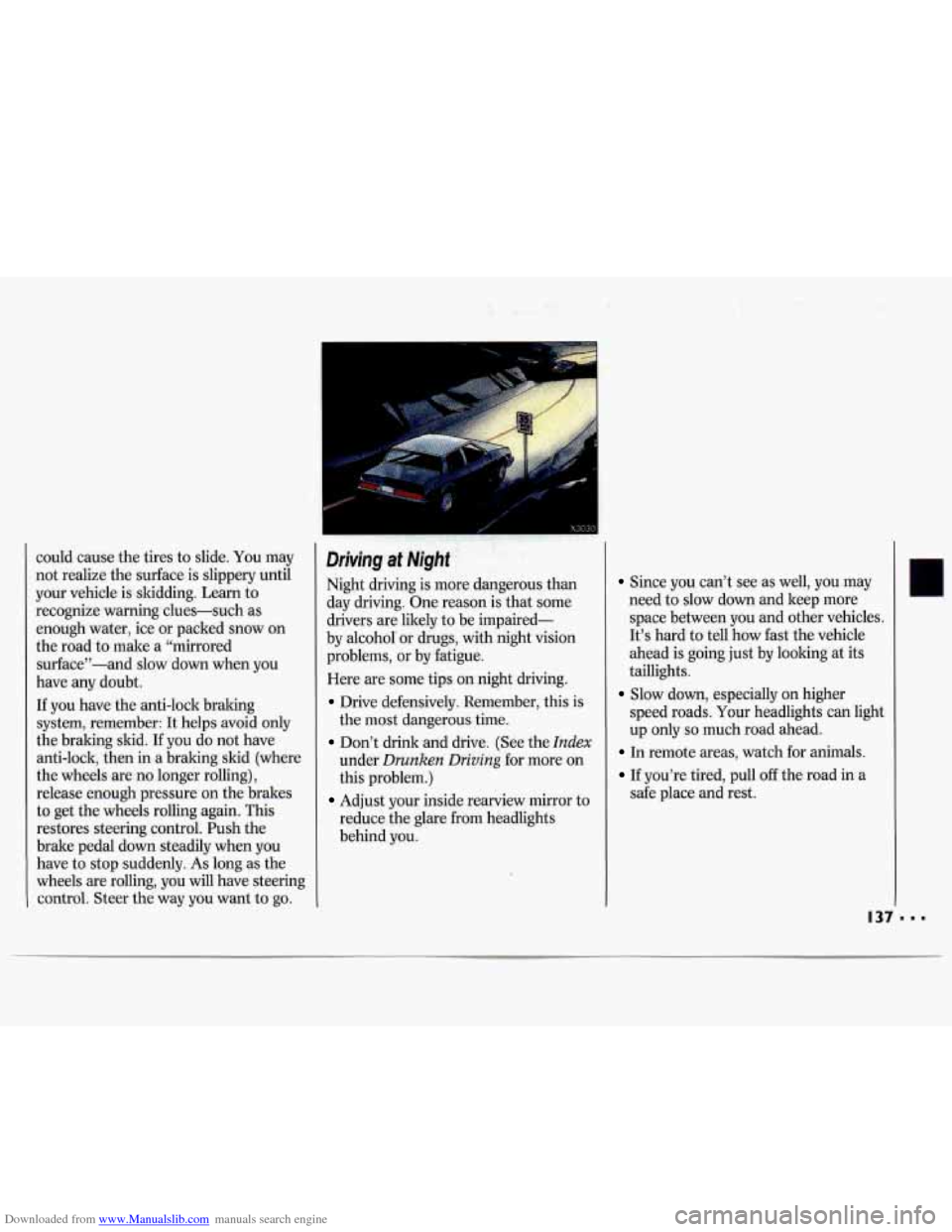
Downloaded from www.Manualslib.com manuals search engine -.,.. -
could cause the tires to slide. You may
not realize the surface is slippery until
your vehicle is skidding. Learn to
recognize warning clues-such as
enough water, ice or packed snow on
the road to make a “mirrored
surface”-and slow down when you
have any doubt.
If you have the anti-lock braking
system, remember: It helps avoid only
the braking
skid. If you do not have
anti-lock, then
in a braking skid (where
the wheels are no longer rohg),
release enough pressure on the brakes
to get the wheels rolling again.
This
restores steering control. Push the
brake pedal down steadily when
you
have to stop suddenly. As long as the
wheels are rolling, you will have steering
control. Steer the way you want to
go.
-
X3030 , , -;. - ., ,
Driving. at Might
Night driving is more dangerous than
day driving. One reason is that some
drivers are likely to be impaired-
by alcohol or drugs, with night vision
problems,
or by fatigue.
Here are some tips on night driving.
Drive defensively. Remember, this is
the most dangerous time.
Don’t drink and drive. (See the Index
under Drunken Driving for more on
this problem.)
Adjust your inside rearview mirror to
reduce the glare from headlights
behind you.
Since you can’t see as well, you may
need to slow
down and keep more
space between you
and other vehicles.
It’s hard to tell how fast the vehicle
ahead’is going just by looking at its
taillights.
Slow down, esp.ecially on higher
speed roads. Your headlights can light
up only so much road ahead.
In remote areas, watch for animals.
If you’re tired, pull off the road in a
safe place and rest.
Page 154 of 324
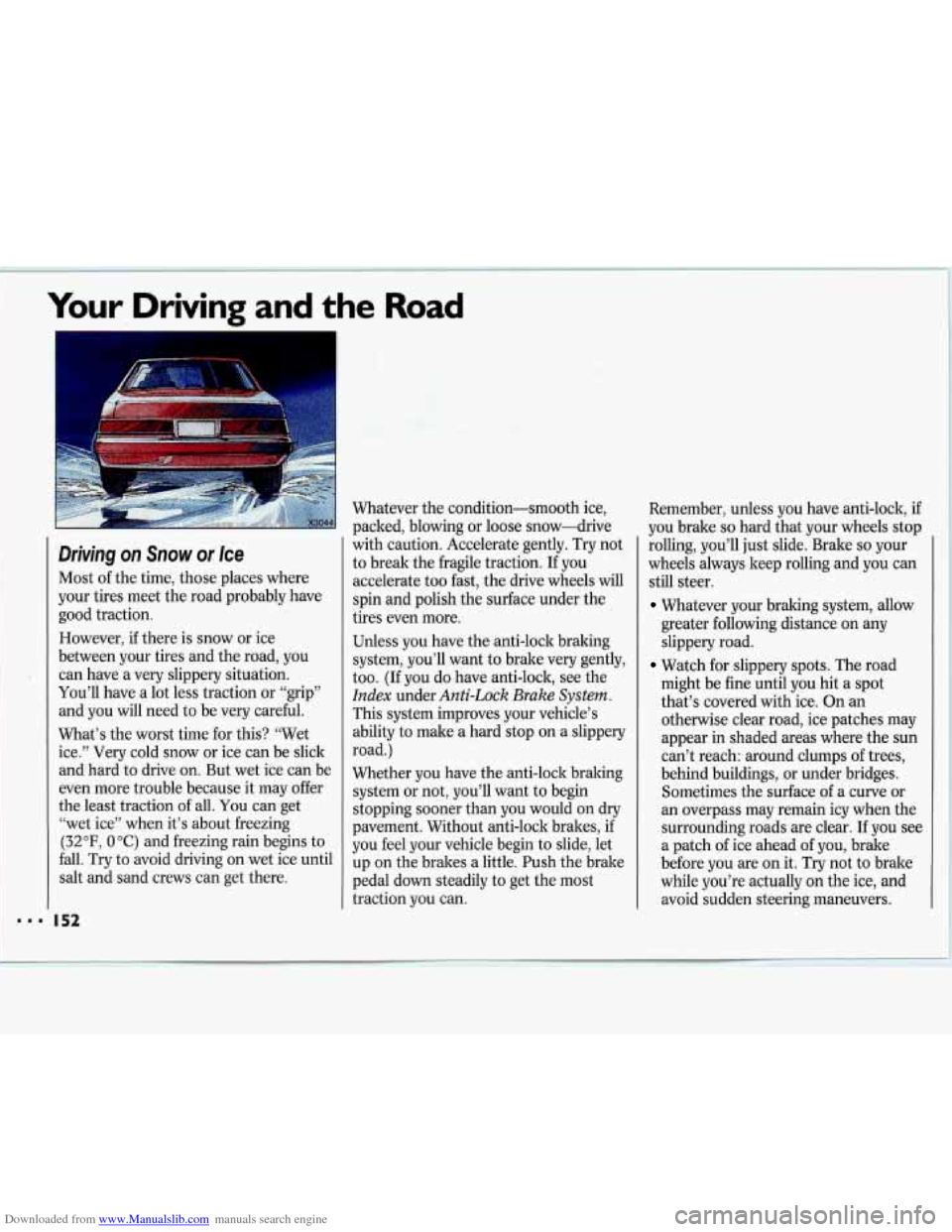
Downloaded from www.Manualslib.com manuals search engine Your Driving and the Road
Driving on Snow or Ice
Most of the time, those places where
your tires meet the road probably have
good traction.
However, if there is snow or ice
between your tires and the road, you
can have a very slippery situation.
You’ll have a lot less traction or “grip”
and you will need to be very careful.
What’s the worst time for this? “Wet
ice.” Very cold snow or ice can be slick
and hard to drive on. But wet ice can be
even more trouble because it may offer
the least traction of all. You can get
“wet ice” when it’s about freezing
(32°F’ 0 “C) and freezing rain begins to
fall. Try to avoid driving on wet ice until
salt and sand crews can get there. Whatever
the condition-smooth ice,
packed, blowing or loose snow-drive
with caution. Accelerate gently. Try not
to break the fragile traction. If you
accelerate too fast, the drive wheels will
spin and polish the surface under the
tires even more.
Unless you have the anti-lock braking
system, you’ll want to brake very gently,
too. (If you do have anti-lock, see the
Index under Anti-Lock Brake System.
This system improves your vehicle’s
ability to make a hard stop on a slippery
road.)
Whether you have the anti-lock braking
system or not, you’ll want to begin
stopping sooner than you would on dry
pavement. Without anti-lock brakes,
if
you feel your vehicle begin to slide, let
up on the brakes a little. Push the brake
pedal down steadily to get the most
traction you can. Remember, unless you have anti-lock,
if
you brake
so hard that your wheels stop
rolling, you’ll just slide. Brake
so your
wheels always keep rolling and you can
still steer.
Whatever your braking system, allow greater following distance on any
slippery road.
Watch for slippery spots. The road
might be fine until you hit a spot
that’s covered with ice. On an
otherwise clear road, ice patches may
appear in shaded areas where the sun
can’t reach: around clumps
of trees,
behind buildings, or under bridges.
Sometimes the surface of
a curve or
an overpass may remain icy when the
surrounding roads are clear. If you see
a patch of ice ahead of you, brake
before you are on it. Try not to brake
while you’re actually on the ice, and
avoid sudden steering maneuvers.
Page 161 of 324

Downloaded from www.Manualslib.com manuals search engine Driving with a Trailer
Towing a trailer requires a certain
amount of experience. Before setting out for the open road, you’ll want to get
to know your rig. Acquaint yourself
with the feel of handling and braking
with the added weight of the trailer.
And always keep in mind that the
vehicle you are driving is now
a good
deal longer and not nearly
so responsive
as your vehicle is by itself.
Before you start, check the trailer hitch
and platform, safety chains, electrical connector, lights, tires and mirror
adjustment. If the trailer has electric
brakes, start your vehicle and trailer
moving and then apply the trailer brake
controller by hand to be sure the brakes
are worling. This lets you check your
electrical connection at the same time. During your
trip, check occasionally to
be sure that the load is secure, and that
the lights and any trailer brakes are still
working.
Following Distance
Stay at least twice as far behind the
vehicle ahead
as you would when
driving your vehicle without a trailer.
This can help you avoid situations that
require heavy braking and sudden
turns.
Passing
You’ll need more passing distance up
ahead when you’re towing a trailer.
And, because you’re a good deal longer,
you’ll need to go much farther beyond
the passed vehicle before you can return
to your lane.
Backing Up
Hold the bottom of the steering wheel
with one hand. Then, to move the
trailer to the left, just move that hand
to
the left. To move the trailer to the right,
move your hand to the right. Always
back up slowly and, if possible, have
someone guide you.
Page 172 of 324

Downloaded from www.Manualslib.com manuals search engine Problems on the Road
Towing Your Chevrolet (CONT.)
When your vehicle is being towed, have
the ignition key
off. The steering wheel
should be clamped in a straight-ahead
position, with a clamping device designed for towing service.
Do not use
the vehicle’s steering column lock for
this. The transaxle should be in
N (Neutral) and the parking brake
released.
Don’t have your vehicle towed on the
front wheels, unless you must. If the
vehicle must be towed on the front
wheels and it is not a
2-34, don’t go
more than
35 mph (56 km/h) or farther
than
50 miles (80 km) or your transaxle
will be damaged. If you must tow a 2-34
on the front wheels, don’t go more than
55 mph (90 Wh) or farther than 500
miles (804 lun) or your transaxle will be
damaged. If these limits must be
exceeded, then the front wheels have to
be supported on a dolly.
A vehicle can fall from a car
carrier if it isn’t properly
secured. This can cause a collision,
serious personal injury and vehicle
damage. The vehicle should
be
tightly secured with chains or steel
cables before it is transported.
Don’t use substitutes (ropes,
leather straps, canvas webbing,
etc.) that can be cut by sharp edges
Towing from the Front-
Vehicle
Hookup
I
Before hooking up to a tow truck, be
sure to read all the information on
Towing Your Cheurolet earlier in this
section.
1. Attach T-hook chains into the side
slots in the cradle in front of the
wheels, on both sides.
I
Page 182 of 324
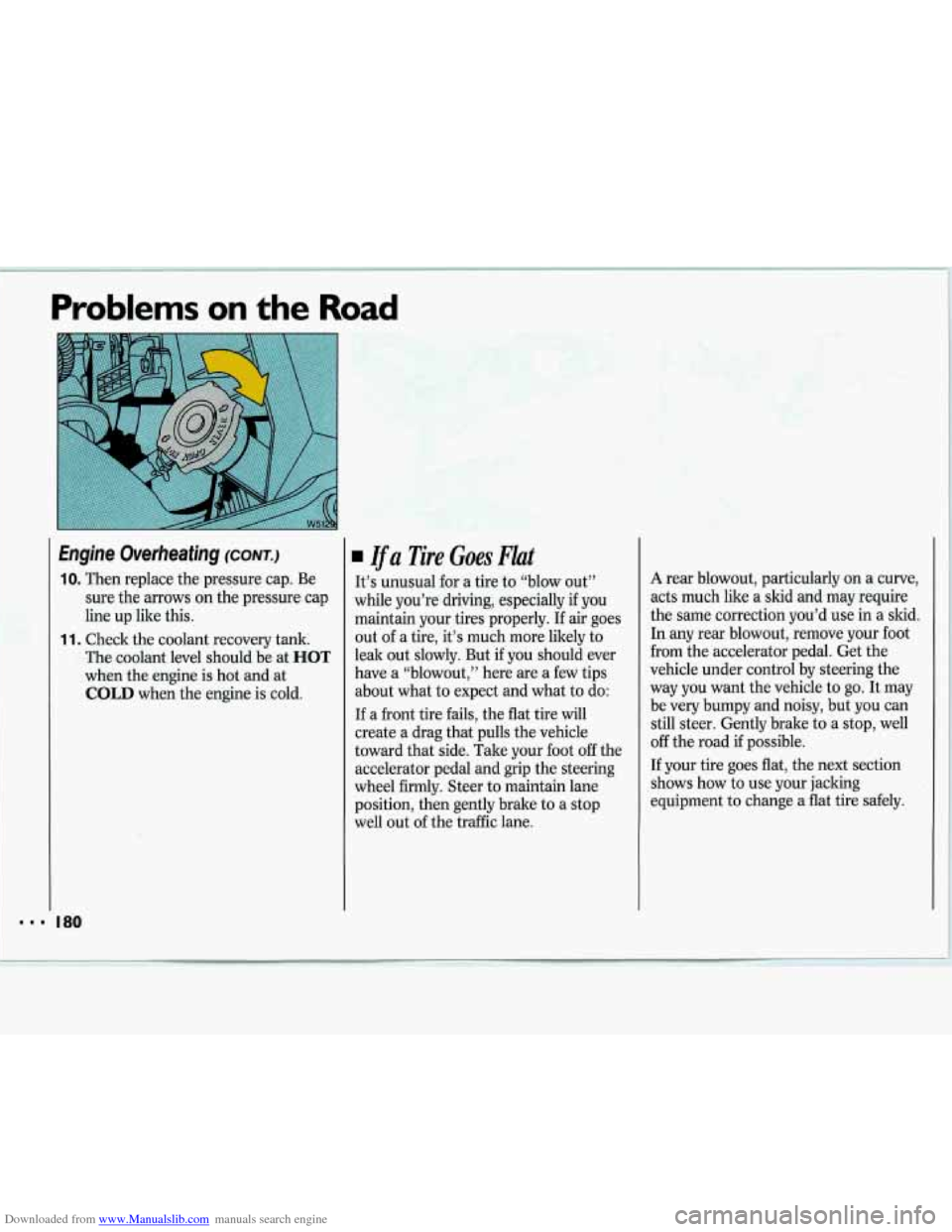
Downloaded from www.Manualslib.com manuals search engine Problems on the Road
Engine Overheating (CONT.)
10. Then replace the pressure cap. Be
sure the arrows on the pressure cap
line up like this.
1 1. Check the coolant recovery tank.
The coolant level should be at
HOT
when the engine is hot and at
COLD when the engine is cold.
- i: .:-
Ifa Tire Goes Flat
It’s unusual for a tire to “blow OU~,)
while you’re driving, especially if you
maintain your tires properly. If air goes
out of a tire, it’s much more likely to
leak out slowly. But
if you should ever
have a “blowout,” here are a few tips
about what to expect and what to do:
If a front tire fails, the flat tire will
create a drag that pulls the vehicle
toward that side. Take your foot
off the
accelerator pedal and grip the steering
wheel firmly. Steer to maintain lane
position, then gently brake to a stop
well out of the traffic lane.
A rear blowout, particularly on a curve,
acts much like a
skid and may require
the same correction you’d use in a
skid.
In any rear blowout, remove your foot
from the accelerator pedal. Get the
vehicle under control by steering the
way you want the vehicle to go. It may
be very bumpy and noisy, but you can
still steer. Gently brake to a stop, well
off the road if possible.
If your tire goes flat, the next section
shows how
to use your jacking
equipment to change a
flat tire safely.